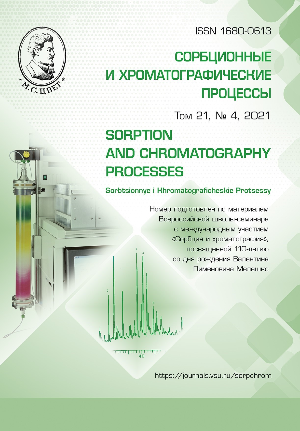nfluence of various factors on the non-exchange sorption of amino acids by anion exchangers
Abstract
In order to review a number of factors involved in the non-exchange sorption of amino acids by ion exchangers, we studied the influence of the nature and ionic form of the sorbent, sorbate, and solvent and the sorption conditions (the temperature and the concentration range) on the absorption of glycine and phenylalanine by an AV-17-2P anion exchanger and a MN-150 hypercross-linked sorbent from aqueous and alcoholic solutions at temperatures of 293 and 343 K within the concentration ranges limited by the solubility of amino acids.
It was established that a change in the ionic form of the AV-17-2P anion exchanger from chloride to nitrate results in a decrease in the amount of absorbed phenylalanine. This is due to changes in the dimensional and hydration characteristics of the counterion which lead to a weakening of polar interactions in the sorbent phase and non-exchange attachment of amino acids. Using non-aqueous solvent, for example, ethyl alcohol, results in a decrease in the solubility of amino acids, and, therefore, in the working range of concentrations, and a decrease in ion exchanger swelling. As a result, a smaller amount of amino acid was absorbed.
Using a hypercross-linked sorbent or an increase in temperature led to a significant improvement in the phenylalanine absorption. In the former case, the hydrophobic interactions between the aromatic group of phenylalanine and the sorbent matrix were enhanced. In the latter case, the multidirectional effect of the temperature factor on the sorbate, sorbent, and the bonds between them ultimately led to an increase in sorption due to improved swelling of the ion exchanger.
The good solubility of glycine allows studying the absorption of this amino acid over a wide range of concentrations. The type of the obtained isotherm and the consideration of the characteristics of the ion exchanger allowed establishing that the first and second layers of the substance were successively formed on the sorption centres “functional group-counterion” in the sorbent.
Downloads
References
Khоkhlоvа О.N., Kashirtseva E.R., Khоkhlоv V.Yu., Trуnаеvа Е.S., Russian Journal of Physical Chemistry A, 2021, Vol. 95, No 4, pp. 762-768.
Trуnаеvа Е.S., Khоkhlоvа О.N., Khоkhlоv V.Yu., Sоrbtsiоnnyе i khrоmаtоgrаfichеskiе prоtsеssy, 2018, Vol. 18, No 2, pp. 142-149.
Bowden N.A., Johan P.M. Sanders, Bru-ins M.E., Journal of Chemical & Engineer-ing, 2018, No 63, pр. 488-497.
Khоkhlоv V.Yu., Sеlеmеnеv V.F., Khоkhlоvа О.N., Zagorodny A.A., Vestnik VGU. Seriya:Khimiya, Biologiya, Pharmatsiya, 2003, No 1, pp. 18-22.
Dougherty R.C., J. Chem. Phys., 1998, Vol. 109, pp. 7372. https://doi.org/10.1063/1.477343
Schellman J.A., Biophys J., 1997, Vol. 73, No 6, pp. 2960-2964. https://doi: 10.1016/S0006-3495(97)78324-3
Gеlfеrikh F., Iоnity: Оsnоvy iоnnоgо оbmеnа. M., Izd-vо inоstr. lit-ry, 1962, 490 p.
Krachak A.N., Khamizov R.H., Dolgon-osov A.M., Malykova L.M., Sоrbtsiоnnyе i khrоmаtоgrаfichеskiе prоtsеssy, 2014, Vol. 14, No 6, pp. 902-911.
Dawson R.M.C., Elliott W.H., Elliott D.C., Jones K.M., Data for Biochemical Re-search, 1989, 592 p.







